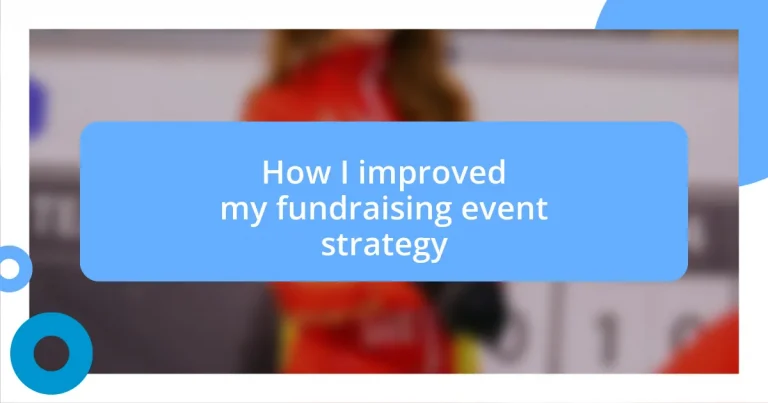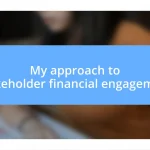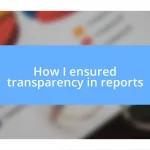Key takeaways:
- Identifying dual goals for fundraising events—financial targets and long-term community engagement—enhances success.
- Understanding and analyzing target audience preferences through surveys and social media ensures event relevance and engagement.
- Crafting a compelling narrative around the organization’s impact fosters emotional connections and motivates donations.
- Effective use of social media and influencer partnerships amplifies outreach and builds a community of advocates for the cause.
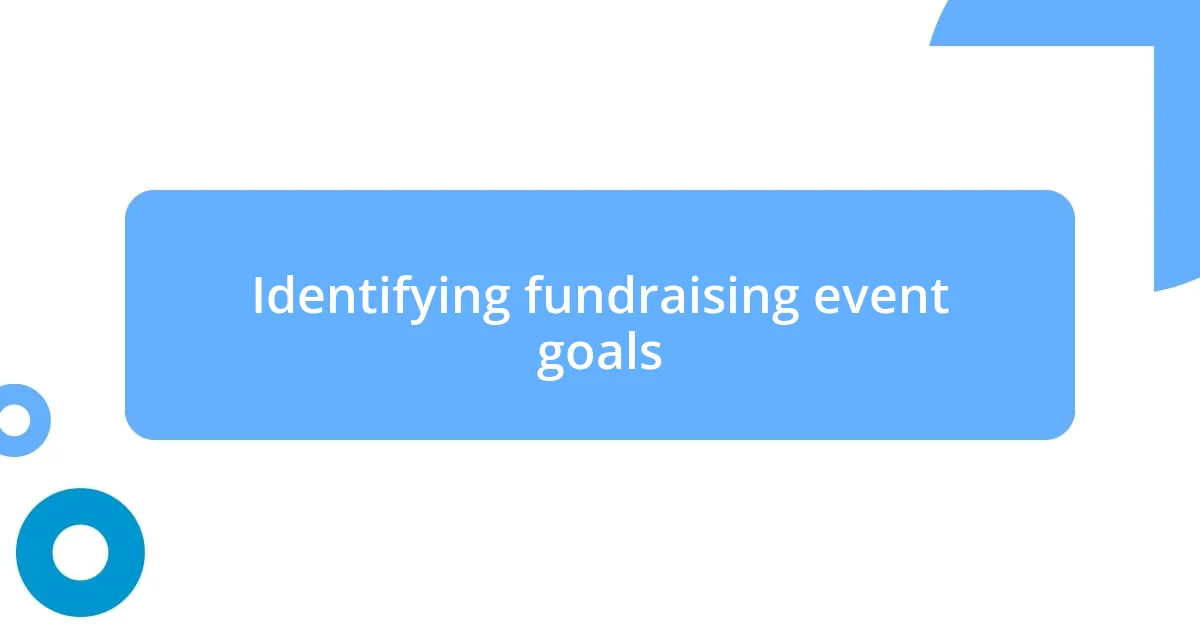
Identifying fundraising event goals
Identifying the goals for your fundraising event is crucial for success. I remember when I first started organizing events; I felt overwhelmed by the possibilities. Should I focus on raising a specific amount of money or perhaps raise awareness for a cause? These questions guided me in defining clear objectives, which ultimately led to more effective planning.
When I finally honed in on my goals, I realized I needed to balance both immediate financial targets with long-term community engagement. For example, one year we aimed to raise $10,000, but equally important was the desire to forge connections with local businesses. This dual focus not only increased our funds but also created lasting partnerships that benefit us year after year.
As you think about your own fundraising event, ask yourself: What impact do I want to create beyond just the dollars raised? Reflecting on this can help you set meaningful goals. From my experience, it’s about crafting an experience that resonates with your audience while maintaining financial objectives. That’s when the magic truly happens!
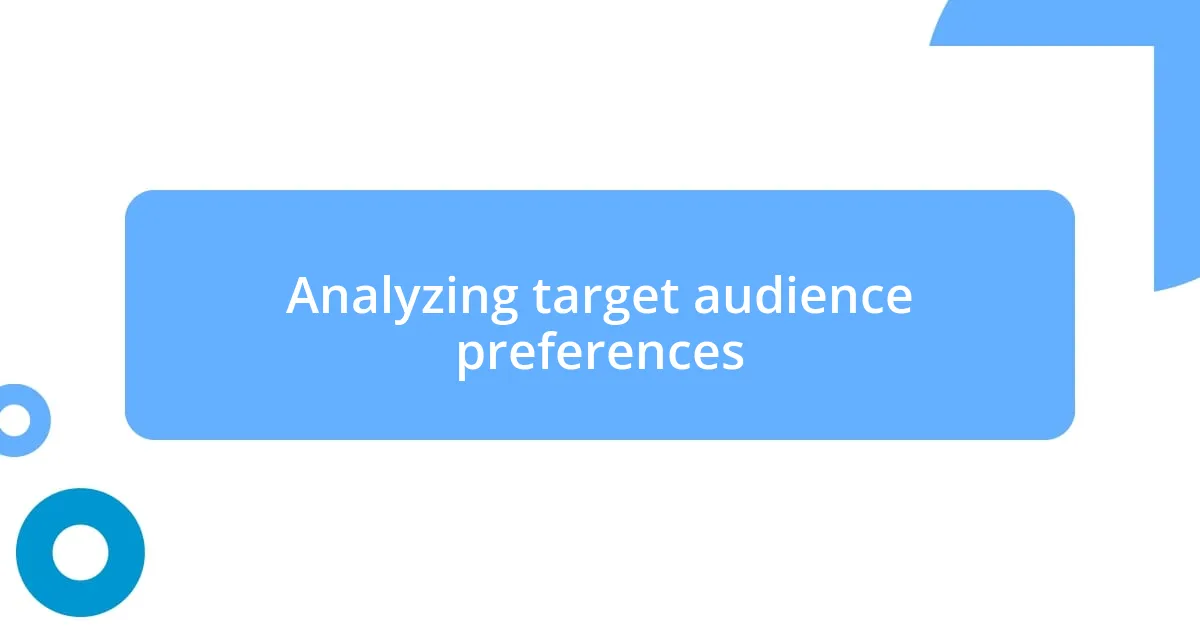
Analyzing target audience preferences
Understanding your target audience is vital. I learned this firsthand when I noticed a significant drop in participation at one of our events. It turned out many attendees felt the event didn’t align with their interests. By diving into their preferences, I could tailor our messaging and activities, leading to a much more engaged crowd. People want to feel connected to the cause, so making that connection clear is essential.
Here are some strategies to analyze your audience’s preferences:
- Conduct surveys before your event to gather insights about interests.
- Monitor social media engagement to see what types of content resonate with your audience.
- Host focus groups with past attendees to discuss their experiences and expectations.
- Evaluate past event performances and attendee feedback to identify patterns.
- Leverage demographic data to ensure your event appeals to the right age groups and community segments.
Each of these methods brings you closer to understanding what your audience truly values, making it easier to create events that resonate deeply.
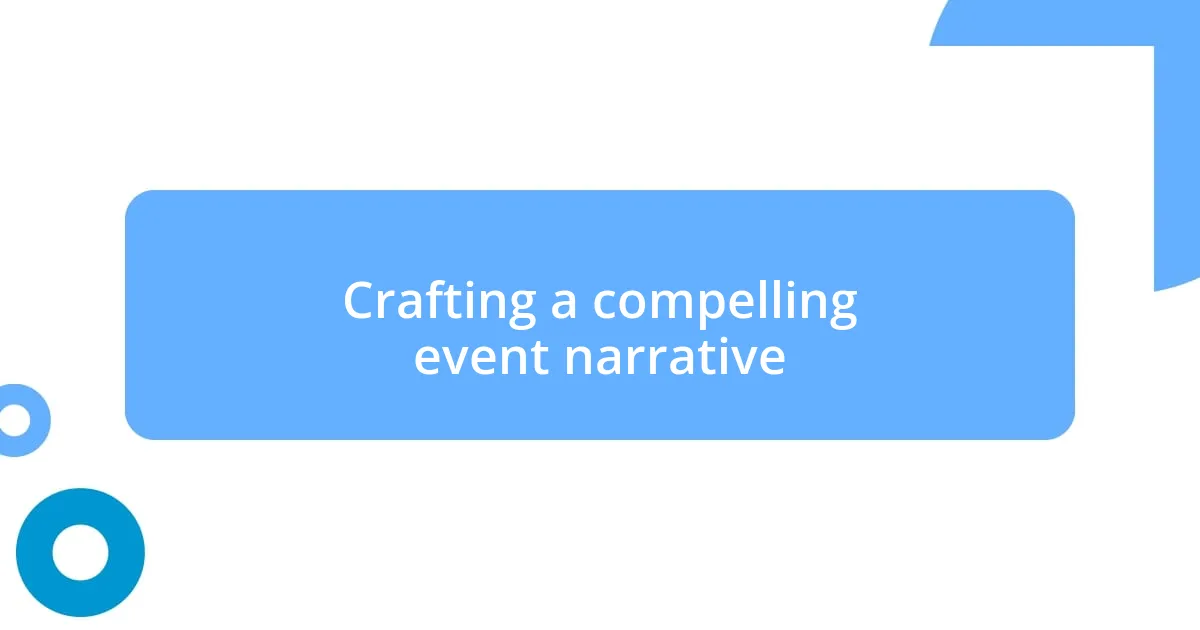
Crafting a compelling event narrative
Crafting a compelling narrative for your fundraising event can truly set the stage for success. I recall a time when I structured our event as a story rather than just a list of activities. This shift brought our mission to life, allowing attendees to feel emotionally connected. By sharing personal stories from beneficiaries, we transformed a simple evening into a powerful experience—one that resonated deeply and encouraged donations.
One effective way to build your narrative is to highlight the journey of your organization’s impact. I remember sharing how a previous fundraiser helped local families in need. This storytelling not only captivated the audience but also laid the groundwork for our current goals, inspiring participants to see how their contributions directly affect real lives. Connecting the dots between past achievements, current needs, and future ambitions creates a compelling reason for guests to contribute.
Creating a cohesive storyline also helps with marketing your event. When promoting, I focus on the narrative arc—introducing challenges, showcasing triumphs, and inviting supporters to join the next chapter. This approach not only increases engagement but also gives potential donors a sense of purpose, making them a part of something larger than themselves. As I often say, good storytelling in fundraising is akin to a well-told adventure; it draws people in and propels them to take action.
| Storytelling Elements | Impact on Fundraising |
|---|---|
| Personal Testimonials | Create emotional connections that drive donations. |
| Organization’s Journey | Highlight successes that invite support for future efforts. |
| Cohesive Narrative | Engage audience and motivate them to act for a greater cause. |
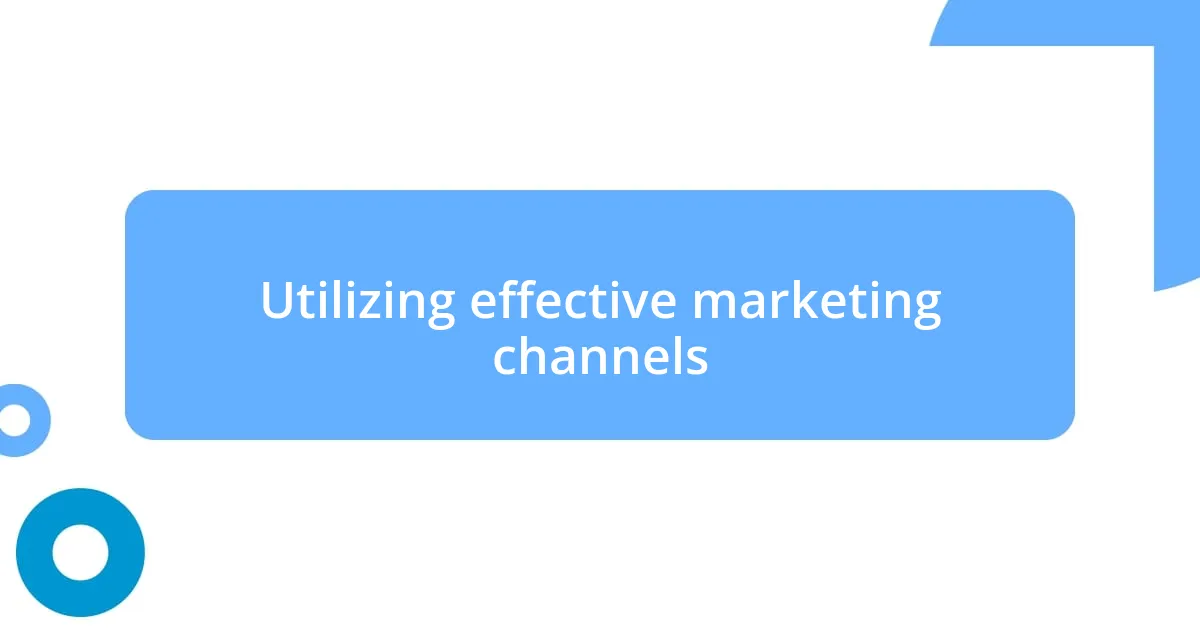
Utilizing effective marketing channels
Utilizing effective marketing channels has been a game-changer for my fundraising events. I experimented with various platforms, focusing heavily on social media, and noticed how each channel attracts a different audience segment. For instance, I found Instagram to be particularly effective for visual storytelling, while Facebook worked wonders for engaging a community-oriented crowd. Have you ever considered how the right platform could transform your outreach efforts?
One memorable instance was when I partnered with a local influencer on TikTok. We created a fun promotional video that captured the essence of our event and sparked conversations all over town. The result? A flood of interest and registrations that far surpassed my expectations. This taught me that aligning my marketing channels with current trends could dramatically enhance engagement.
I also learned to segment my email marketing lists based on past attendee behaviors—this approach allowed me to tailor messages to specific groups. Personalized invitations led to higher open rates and increased turnout. It’s fascinating to see how a little strategy in choosing the right channels can yield significant returns. What channels have you found effective in your fundraising journey?
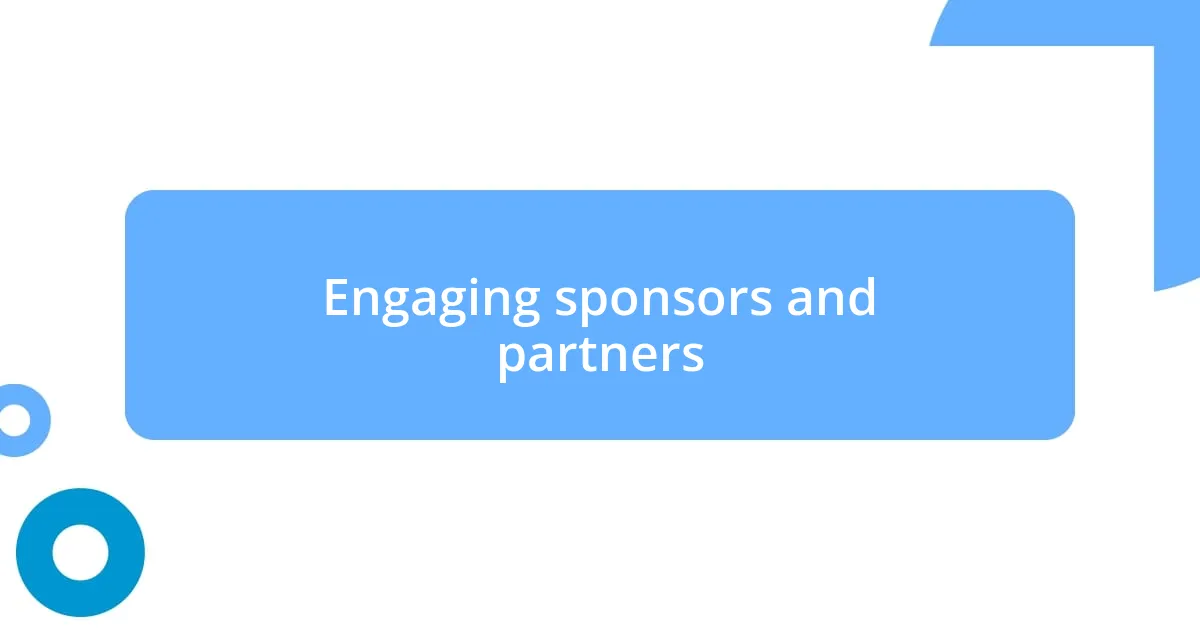
Engaging sponsors and partners
Engaging sponsors and partners requires a thoughtful approach. I remember when we tried to align our mission closely with the interests of a potential corporate sponsor. By demonstrating how their support could amplify both our cause and their brand visibility, we crafted a proposal that resonated with them. This connection was more than transactional; it became a collaborative effort, creating a sense of shared purpose.
I find that transparency plays a crucial role in building strong relationships with sponsors. For example, during a past event, I made it a point to keep our sponsors informed throughout the planning process, highlighting their contributions and the impact they made. This not only reinforced their commitment but also allowed them to take pride in our shared success. I often ask myself—how can I involve sponsors in a way that makes them feel like they’re truly part of the team? The answer lies in continuous communication and involving them in key decisions.
Moreover, I’ve discovered that showing appreciation for our partners is paramount. After an event, sending personalized thank-you notes or recognizing sponsors publicly can deepen those relationships. One time, we featured a sponsor’s contribution in a press release, and it led to them wanting to partner again for future events. It’s remarkable how small gestures can foster loyalty and open doors for ongoing collaboration. Have you thought about how you express gratitude to your partners? Little things can often lead to big opportunities.
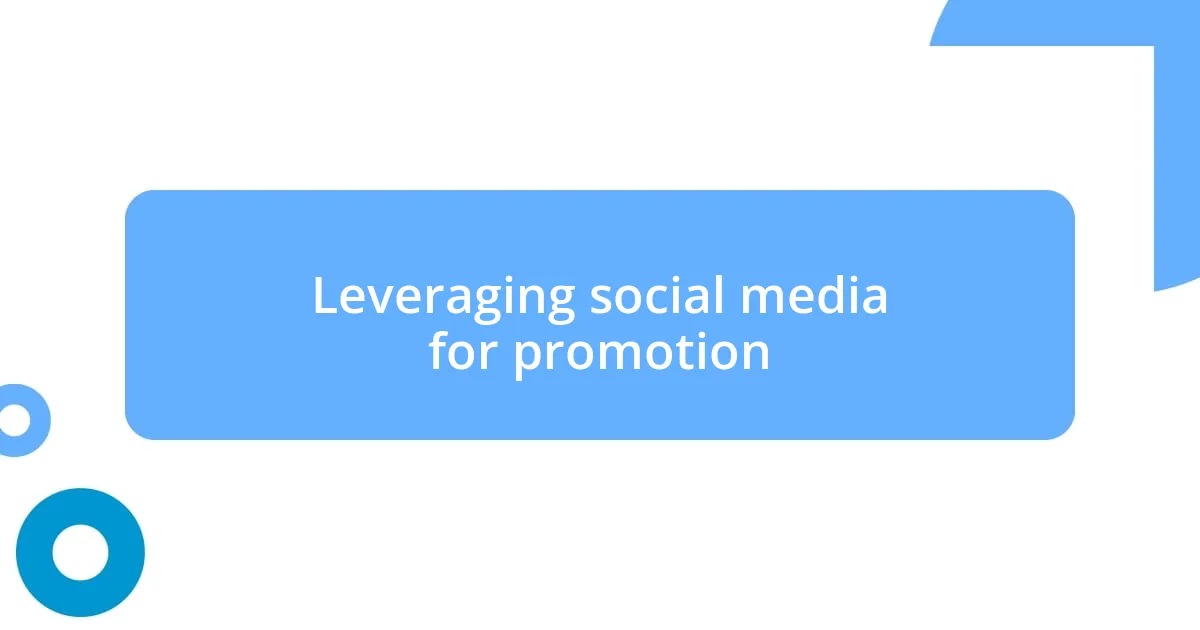
Leveraging social media for promotion
Using social media for promotion has truly transformed the way I approach fundraising events. I vividly remember the excitement I felt when I crafted a campaign on Twitter that encouraged attendees to share their personal stories related to our cause. The result was heartwarming—seeing our community come together, sharing their narratives, and spreading the word organically made me realize the power of authentic engagement. Isn’t it fascinating how organic conversations can foster a sense of community?
I learned the hard way that simply posting about an event wasn’t enough; timing and content mattered immensely. For instance, I experimented with live video sessions on Instagram, where I offered sneak peeks into event preparations and engaged directly with potential attendees. The real-time interaction created a buzz that not only boosted awareness but also made me feel more connected to my audience. How would you feel if you had a chance to interact with the cause you care about in such a personal way?
Collaboration with social media influencers turned out to be a pivotal strategy for me. I reached out to micro-influencers who were passionate about our mission and invited them to promote our event. Their authentic reach introduced our cause to new audiences. One influencer’s story about how our event impacted them personally led to a significant spike in ticket sales. Can you imagine the ripple effect of having someone genuinely passionate about your mission sharing it with their followers? It’s not just marketing; it’s building a community of advocates who believe in your cause.
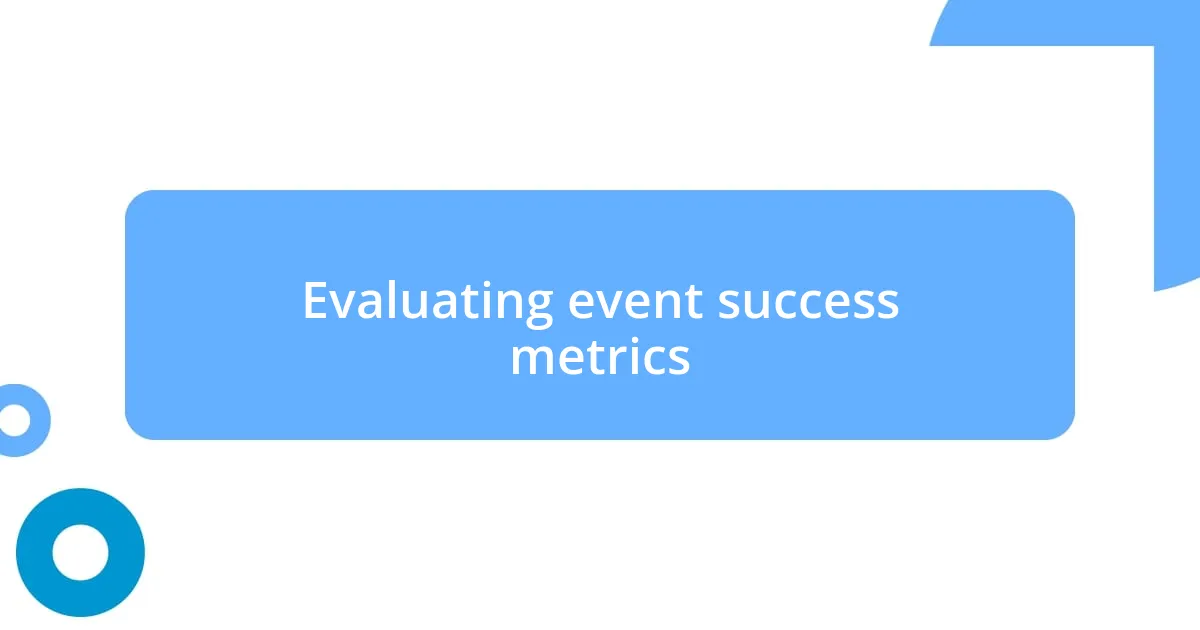
Evaluating event success metrics
Evaluating the success of a fundraising event often involves a detailed look at various metrics. Reflecting on my experiences, I realized that tracking ticket sales, donation amounts, and overall attendance gives only part of the picture. For instance, after one of our events, I dug deeper and analyzed attendee engagement through surveys, and that provided me invaluable feedback on their experiences. Have you ever considered how attendee satisfaction could impact future events?
Beyond the numbers, I’ve found that monitoring social media engagement plays a crucial role in evaluation. During one event, we noticed an impressive spike in online mentions and shares. It was gratifying to see our community actively promoting our cause. This kind of buzz is something I consider essential; it indicates that the event resonated with our audience. How do you gauge the passion and enthusiasm of your participants?
Analyzing post-event fundraising outcomes is where the real insights lie. I recall a particular event where our follow-up campaign yielded more donations than expected. By meticulously examining which marketing strategies drove those donations, I was able to refine my approach for the next event. Each data point helps paint a clearer picture of what works—small tweaks can lead to significantly improved results. Isn’t it rewarding when you can see direct correlations between your efforts and the positive impact they create?












